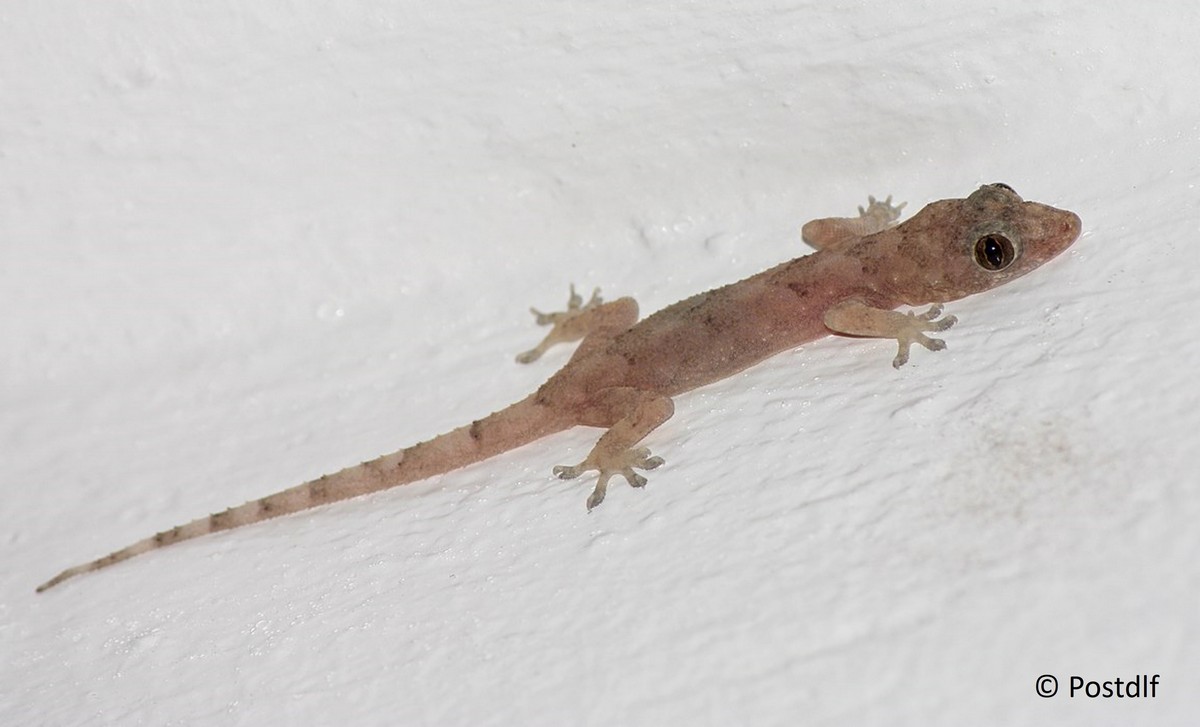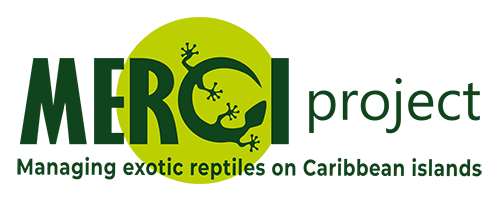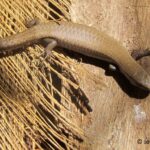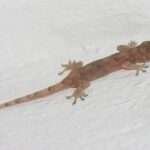
- Nom vernaculaire: Hémidactyle commun, Gecko des maisons
- Nom scientifique : Hemidactylus mabouia (Moreau de Jonnès, 1818)
- Nom local: House gecko, Moreau’s tropical gecko, Wood Slave gecko, Wood Slave
- Ordre : Gekkonidae
- Famille : Squamata
Description
Morphologie. L’Hémidactyle commun est un gecko de taille moyenne, qui se distingue par la présence d’une longue griffe sur chacun des cinq doigts, de nombreux tubercules sur le dos, et six rangées longitudinales de tubercules épineux sur la queue (Powell et al., 1998; HerpMe, Société Herpétologique de France). La couleur du corps et des motifs dorsaux varie du blanc et gris clair au marron foncé. La queue est généralement marquée d’anneaux sombres (Powell et al., 1998; HerpMe, Société Herpétologique de France).
Taille corporelle standard (longueur tête-tronc). mâles: 42 à 67,9 mm; femelles: 42 à 72 mm (Powell et al., 1998; HerpMe, Société Herpétologique de France).
Dimorphisme sexuel. Les femelles sont généralement plus grandes que les mâles.
Variations. La couleur du corps d’un même individu peut varier du clair au sombre, selon son état.
Confusion possible avec d’autres espèces. Dans les Antilles, la confusion est possible avec le Gecko nain Lepidodactylus lugubris. Cependant, le Gecko nain se distingue par la présence de griffes sur seulement quatre des cinq doigts (le pouce en est dépourvu), un corps d’aspect lisse, sans tubercules, avec un motif dorsal à base de taches noires symétriques, parfois discrètes, en forme de « V », de « W » ou sous forme de points. La base de la queue est également légèrement élargie (HerpMe, Société Herpétologique de France).
Distribution
Native. Afrique: Mali, Sénégal, Guinée, Côte d’Ivoire, Ghana, Togo, Bénin, Nigéria, Tchad, Cameroun, Gabon, Sao Tomé-et-Principe, République de Centrafrique, République Démocratique du Congo, Angola, Namibie, République d’Afrique du Sud, Eswatini, République du Soudan du Sud, Ouganda, Tanzanie, Zambie, Zimbabwe, Érythrée, Éthiopie, Kenya, Mozambique, Seychelles (e.g. Powell et al., 1998).
Introduit. Floride (Krysko et Daniels, 2005; Meshaka et al., 2006; Meshaka, 2011; Burke et Lieto, 2019), Mexique, Honduras (McCranie, 2015), Costa Rica, Panama, Colombie, Venezuela (Fuenmayor et al., 2005), Guyana, Suriname (Jairam et al., 2016), Guyane (Hoogmoed, 1975), Équateur (Torres-Carvajal et al., 2019), Pérou, Bolivie, Brésil (Telles et al., 2015; Mageski et al., 2017; Franzini et al., 2019; Oliveira Neves et al., 2019; Cozer et al., 2020), Paraguay, Uruguay, Argentine (Torres et al., 2018), Madère (Jesus et al., 2002).
Caraïbes: Bermudes (Outerbridge et Massey, 2018), Eleuthera Island (Bahamas) (Johnson et al., 2013), Great Inagua (Bahamas) (Griffing et Bauer, 2016), Cuba (Iturriaga et Marrero, 2013; Schettino et al., 2013; Borroto-Paez et Pérez, 2019, 2020), Grand Cayman, Brac Island (Barnett et al., 2020), Jamaïque, Îles Turks-et-Caïques (Reynolds, 2012), Mona, Culebra, Porto Rico, Vieques, Îles Vierges Britanniques et Américaines, Anguilla (Howard et al., 2001), Antigua, Barbuda, Redonda (Daltry, 2007), Saint Martin, Saint Barthélemy (Lorvelec et al., 2007), Bonaire, Saint Eustache, Saba, Saint Kitts et Nevis, Montserrat, Guadeloupe (Lorvelec et al., 2007), Dominique, Martinique (Lorvelec et al., 2007), Sainte Lucie, Grenade, Saint Vincent et les Grenadines, Barbade, Trinidad, Tobago (Auguste, 2019), Curaçao (Hughes et al., 2015).
Biologie et écologie
Habitat. La distribution globale de l’Hémidactyle commun reflète sa préférence pour un climat tropical à sub-tropical (Rödder et al., 2008). L’espèce est capable d’évoluer dans une grande diversité d’habitats naturels et anthropisés. Hemidactylus mabouia est particulièrement présent dans les habitats forestiers, ainsi que dans les milieux urbains et sub-urbains.
Régime alimentaire. Se nourrit essentiellement de petits arthropodes: insectes, arachnides et crustacés (Rocha et Anjos, 2007; Iturriaga et Marrero, 2013).
Reproduction. La reproduction a lieu tout au long de l’année, avec un pic d’Aout à Décembre. Les femelles sont capables de stocker le sperme, et peuvent pondre jusqu’à sept fois dans l’année. Deux œufs sont pondus par nid, et l’incubation dure entre 22 et 68 jours (58 jours en moyenne).
Comportement. L’Hémidactyle commun est une espèce territoriale qui peut avoir des comportements agressifs envers ses congénères ou d’autres espèces de reptiles.
Impact et gestion des populations introduites
Impact. Hemidactylus mabouia peut entrer en compétition avec les espèces natives. Hughes et collègues (2015) ont ainsi observé à Curaçao le déplacement de l’espèce native de gecko, Phyllodactylus martini, des sites habituellement occupés, sous la pression de l’Hémidactyle commun.
D’autres auteurs ont également rapporté des interactions compétitives avec une espèce d’anole native de Cuba, Anolis porcatus, sans pour autant observer un déplacement de l’espèce (Borroto-Paez et Pérez, 2019).
Gestion. Aucune mesure de contrôle ciblée n’est à ce jour établie dans les différentes régions d’introduction de l’espèce.
Bibliographie
- Auguste, R. J. (2019). Herpetofaunal checklist for six pilot protected areas in Trinidad and Tobago. Herpetology Notes, 12, 577–585.
- Barnett, J. C., Poe, S. J., & Haakonsson, J. (2020). Hemidactylus mabouia (Wood Slave). British West Inides. Herpetological Review, 51, 540.
- Borroto-Páez, R., & Pérez, D. R. (2019). Competitive interference between an endemic Cuban Green Anole (Anolis porcatus) and invasive Tropical House Geckos (Hemidactylus mabouia). IRCF Reptiles and Amphibians, 26, 43–46.
- Borroto-Páez, R., & Pérez, D. R. (2020). Predation by a Cuban Treefrog Cuba (Osteophilus septentrionalis) and a domestic cat (Felis catus) on Tropical House Geckos (Hemidactylus mabouia) in central Cuba, with a review of predators and vertebrate prey of Tropical House Geckos. IRCF Reptiles and Amphibians, 27, 120–128.
- Burke, R., & Lieto, M. (2019). Tracking the spread of six invasive amphibians and reptiles using the geographic distribution records published in Herpetological Review. Herpetological Review, 50, 1–7.
- Cozer, J. S., Pereira-Ribeiro, J., Linause, T. M., Ferreguetti, A. C., Bergallo, H. de G., & da Rocha, C. F. D. (2020). Reptile diversity in the duas bocas biological reserve, espírito santo, Southeastern Brazil. Papeis Avulsos de Zoologia, 60, 1–9.
- Daltry, J. C. (2007). An introduction to the herpetofauna of Antigua, Barbuda and Redonda, with some conservation recommendations. Applied Herpetology, 4, 97–130.
- de Oliveira Neves, M., Yves, A., Pereira, E. A., Alves, L., Vasques, J. B., Teixeira Coelho, J. F., & Silva, P. S. (2019). Herpetofauna in a highly endangered area: The triângulo Mineiro region, in Minas Gerais State, Brazil. Herpetozoa, 32, 113–123.
- Franzini, L. D., Da Silva, I. R. S., Santana, D. O., Delfim, F. R., Vieira, G. H. C., & Mesquita, D. O. (2019). Lizard fauna from the state of Paraíba, northeastern Brazil: current knowledge and sampling discontinuities. Herpetology Notes, 12, 749–763.
- Fuenmayor, G. R., Ugueto, G. N., Bauer, A. M., Barros, T., & Manzanilla, J. (2005). Expansion and natural history of a successful colonizing gecko in Venezuela (Reptilia: Gekkonidae: Hemidactylus mabouia) and the discovery of H. frenatus in Venezuela. Herpetological Review, 36, 121–125.
- Griffing, A. H., & Bauer, A. M. (2016). Hemidactylus mabouia (Wood Slave). Bahamas: Great Inadua. Herpetological Review, 47, 80–81.
- Hoogmoed, M. S. (1975). An annotated checklist of the lizards of french Guiana, mainly based on two recent collections. Zoologische Mededelingen, 49, 141–172.
- Howard, K. G., Parmerlee, J., & Powell, R. (2001). Natural history of the edificarian geckos Hemidactylus mabouia, Thecadactylus rapicauda, and Sphaerodactylus sputator on Anguilla. Caribbean Journal of Science, 37, 285–288.
- Hughes, D. F., Meshaka, W. E., & Van Buurt, G. (2015). The superior colonizing gecko Hemidactylus mabouia on Curaçao: Conservation implications for the native gecko Phyllodactylus martini. Journal of Herpetology, 49, 60–63.
- Iturriaga, M., & Marrero, R. (2013). Feeding ecology of the Tropical House Gecko Hemidactylus mabouia (Sauria: Gekkonidae) during the dry season in Havana, Cuba. Herpetology Notes, 6, 11–17.
- Jairam, R., D’Orgeix, C. A., D’Orgeix, C. H., & Harris, A. (2016). range extension and distribution of the invasive Moreau’s Tropical House Gecko, Hemidactylus mabouia (Moreau de Jonnès, 1818) (Squamata: Gekkonidae), in Suriname. Check List, 12, 1978.
- Jesus, J., Freitas, A. I., Brehm, A., & Harris, J. (2002). An introduced population of Hemidactylus mabouia (Moreau de Jonnès, 1818) on Madeira Island. Herpetozoa, 15, 179–180.
- Johnson, S. K., Parmerlee, J. S., Eifler, D. A., & Powell, R. (2013). Comparative water-loss rates of Hemidactylus mabouia and Sphaerodactylus notatus on Eleuthera Island, Commonwealth of the Bahamas. Herpetology Notes, 6, 471–475.
- Krysko, K. L., & Daniels, K. J. (2005). A key to the Geckos (Sauria: Gekkonidae) of Florida. Caribbean Journal of Science, 41, 28–36.
- Lorvelec, O., Pascal, M., Pavis, C., & Feldmann, P. (2007). Amphibians and reptiles of the French West Indies: Inventory, threats and conservation. Applied Herpetology, 4, 131–161.
- Mageski, M., Jesus, P. R., & Ferreira, P. D. (2017). Continued dispersal of the Wood Slave Gecko , Hemidactylus mabouia, in natural environments of Brazil. North-Western Journal of Zoology, 13, 363–364.
- McCranie, J. R. (2015). A checklist of the amphibians and reptiles of Honduras, with additions, comments on taxonomy, some recent taxonomic decisions, and areas of further studies needed. Zootaxa, 3931, 352–386.
- Meshaka, W. E. (2011). A runaway train in the making: the exotic Amphibians, Reptiles, Turtles, and Crocodilians of Florida. Monograph 1. Herpetological Conservation and Biology, 6, 1–101.
- Meshaka, W. E., Cress, H. L., Kingsland, K. L., Smith, H. T., Fitchett, S. A., Moore, J. A., & Cowan, M. (2006). Hemidactylus (House Gecko) assemblage dynamics on South Florida buildings. Journal of Kansas Herpetology, 17, 2–3.
- Outerbridge, M. E., & Massey, S. C. B. (2018). Two new additions to the terrestrial reptiles established on bermuda, with notes on other species. Herpetological Review, 49, 508–510.
- Powell, R., Crombie, R. I., & Boos, H. E. A. (1998). Hemidactylus mabouia (Moreau de Jonnès). Catalogue of American Amphibians and Reptiles, 674, 1–11.
- Reynolds, R. G. (2012). Hemidactylus mabouia (Tropical House Gecko). Distribution. Caribbean Herpetology, 28.
- Rocha, C. F. D., & Anjos, L. A. (2007). Feeding ecology of a nocturnal invasive alien lizard species, Hemidactylus mabouia Moreau de Jonnès, 1818 (Gekkonidae), living in an outcrop rocky area in southeastern Brazil. Brazilian Journal of Biology, 67, 485–491.
- Rödder, D., Solé, M., & Böhme, W. (2008). Predicting the potential distributions of two alien invasive Housegeckos (Gekkonidae: Hemidactylus frenatus, Hemidactylus mabouia). North-Western Journal of Zoology, 4(2), 236–246.
- Schettino, L. R., Mancina, C. A., & González, V. R. (2013). Reptiles of Cuba : checklist and geographic. Smithsonian Herpetological Information Service, 144, 98.
- Telles, F. B. S., Militão, C. M., Bergallo, H. G., & Rocha, C. F. D. (2015). Invasion of the alien gecko Hemidactylus mabouia (Moureau de Jonnès, 1818) in a natural habitat at Praia do Sul Biological Reserve, Ilha Grande, RJ, Brazil. Brazilian Journal of Biology, 75, 768–770.
- Torres-Carvajal, O., Pazmiño-Otamendi, G., & Salazar-Valenzuela, D. (2019). Reptiles of Ecuador: A resource-rich online portal, with dynamic checklists and photographic guides. Amphibian and Reptile Conservation, 13, 209–229.
- Torres, P. J., Escalante, O., & Cardozo, D. (2018). First record of the invasive Hemidactylus mabouia (Moreau de Jonnès, 1818) (Squamata, Gekkonidae), in the dry Chaco, Argentina. Check List, 14, 633–636.





